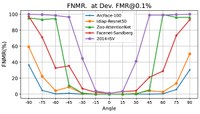Eight Years of Face Recognition Research: Reproducibility, Achievements and Open Issues
Automatic face recognition is a research area with high popularity. Many different face recognition algorithms have been proposed in the last thirty years of intensive research in the field. With the popularity of deep learning and its capability to solve a huge variety of different problems, face recognition researchers have concentrated effort on creating better models under this paradigm. From the year 2015, state-of-the-art face recognition has been rooted in deep learning models. Despite the availability of large-scale and diverse datasets for evaluating the performance of face recognition algorithms, many of the modern datasets just combine different factors that influence face recognition, such as face pose, occlusion, illumination, facial expression and image quality. When algorithms produce errors on these datasets, it is not clear which of the factors has caused this error and, hence, there is no guidance in which direction more research is required. This work is a followup from our previous works developed in 2014 and eventually published in 2016, showing the impact of various facial aspects on face recognition algorithms. By comparing the current state-of-the-art with the best systems from the past, we demonstrate that faces under strong occlusions, some types of illumination, and strong expressions are problems mastered by deep learning algorithms, whereas recognition with low-resolution images, extreme pose variations, and open-set recognition is still an open problem. To show this, we run a sequence of experiments using six different datasets and five different face recognition algorithms in an open-source and reproducible manner. We provide the source code to run all of our experiments, which is easily extensible so that utilizing your own deep network in our evaluation is just a few minutes away.
Code available here
PDF: Eight Years of Face Recognition Research: Reproducibility, Achievements and Open Issues
